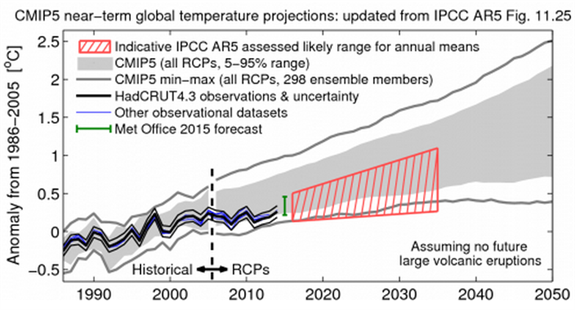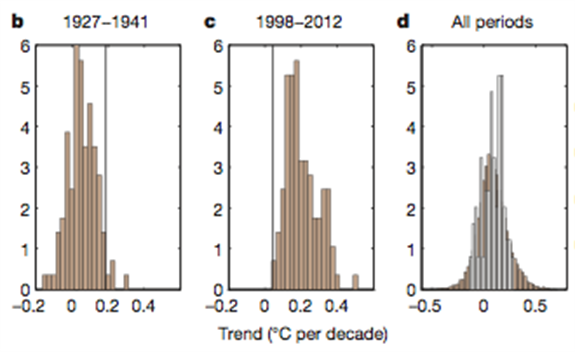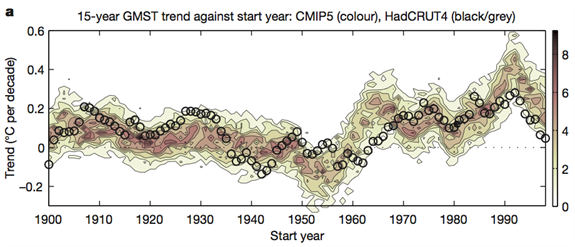
This is a re-post from Roz Pidcock at Carbon Brief
A new paper takes an in-depth look at the suggestion that climate models routinely overestimate the speed at which Earth's surface is warming - and finds the argument lacking.
A look back over the past century shows that, by and large, what we see in global average temperature is extremely well captured by models, the authors tell Carbon Brief.
The new research, a collaboration between scientists at the Max Planck Institute in Germany and the University of Leeds, is published today in the journal Nature.
Climate scientists study how Earth's temperature changes over several decades. They also seek to understand how natural fluctuations influence the picture over shorter time periods.
The past 15 years has received a fair bit of attention. It's notable that 14 of those years topped the charts as the warmest on record. But the difference between individual years has been slight, meaning the earth's surface has risen a fair bit slower than in previous decades.
Most climate models haven't captured this slower rate of warming. Instead, they show continued warming, arriving at global temperatures that are above what we're seeing now.
Prof Tim Osborn, a climate scientist at the University of East Anglia, tells Carbon Brief even the news that 2014 was probably the hottest year on record doesn't change the picture much:
"Despite being very warm, 2014 still leaves the observed warming in the lower part of the range of climate model simulations."

Surface temperature from HadCRUT4 (black line) tracks the lower edge of the 5-95% range of climate model projections (grey shading). Projections are relative to 1986-2005. Updated to include temperature data for 2014. Source: Ed Hawkins, Climate Lab Book
The discrepancy between observed and model trends recently has led some to suggest models could be at fault, the authors explain in a summary accompanying the paper:
"Some have speculated that this difference occurs because climate models respond too sensitively to greenhouse gas increases, and thus overestimate climate change."
This turns out not to be the case, as the paper explains. But first, it's worth remembering that we're talking here about surface temperature, not the globe as a whole, lead author Prof Jochem Marotzke from the Max Planck Institute for Meteorology in Germany. He tells us:
"[Surface temperature is] the temperature of a very thin layer of the climate system. Anthropogenic climate change has continued, it's just not so visible in the surface ... It's clearly visible if you look at the heat stored in the ocean, which has kept going during these 15 years. So climate change is continuing, even though surface warming has slowed down quite a bit."
Choosing a 15-year period over which to examine surface temperatures is arbitrary. You can get almost any trend depending on which year you choose as the starting point.
That's why it's important to look at other 15-year periods in Earth's temperature record to see whether or not the most recent one is unusual, the new paper explains.
The authors looked at every possible 15-year period since the beginning of the 20th century. The first spans the period 1900-1914, the next one 1901-1915 and so on, right up to 2012.
The paper uses surface temperature data from the HadCRUT4 record, jointly produced by the UK Met Office and the Climatic Research Unit at the University of East Anglia (UEA).
For each 15-year period, the authors compared the temperature change we've seen in the real world with what the climate models suggest should have happened.
Over the 112-year record, the authors find no obvious pattern in whether real-world temperature trends are closer to the upper end of what model project, or the lower end.
In other words, while the models aren't capable of capturing all the "wiggles" along the path of rising temperatures, they are slightly too cool just as often as they're slightly too warm.
The paper gives some examples. For the 15-year period starting in 1927, surface temperature is lower in 110 of the 114 model simulations (brown bars in the left graph below) than in the real-world (black line).
The opposite is true for the period starting in 1998, however. All 114 model simulations overestimate the warming we've actually experienced (middle graph).
Taking all 15-year time periods together, the average observed trend since 1900 is 0.086 degrees Celsius per decade. This is almost exactly in line with the model average of 0.088 degrees per decade. You can see the overlap in the right-hand graph below.

Comparing model-simulated (brown bars) and observed global surface temperature (vertical black line) for the 15-year periods covering 1927-1941 (left) and 1998-2012 (middle), and for all 15-year periods between 1900 and 2012 (right). Source: Marotzke and Forster (2015)
So what causes real-world temperatures to diverge from the models over periods as short as 15 years? That's down to natural fluctuations that temporarily boost or dampen the speed of warming, such as the global weather phenomenon known as El Niño, the paper notes.
Such short-term ups and downs are known as internal variability, and they happen partly at random. That means, at any given time, it is largely down to chance as to whether real-world temperatures are higher or lower than models suggest.
The authors don't rule out a minor contribution from some models underestimating cooling from volcanic eruptions. In the past 15 years, the difference between modelled and observed trends has also likely been amplified by unusually rapid uptake of heat by the oceans.

Comparing model simulated and observed 15-year trends of global average surface temperature since 1900, plotted by starting year. Colour shading shows how often a trend occurs. Black circles are HadCRUT4 data. Source: Marotzke and Forster (2015)
Overall, the authors conclude there is no in-built bias in the models over the past 15 years, or any other 15-year period. The paper says:
"The claim that climate models systematically overestimate the response to radiative forcing from increasing greenhouse concentrations therefore seems to be unfounded."
A recent paper by climate skeptic politician Viscount Christopher Monckton claimed scientists' model-based projections of climate change are overstated. But Prof Piers Forster, climate scientist at Leeds University and co-author on the new paper, tells Carbon Brief:
"Our paper completely refutes this. We find no evidence that models are too responsive. In fact, we find the model range is an excellent predictor of observed trends and their uncertainty due to random chaotic processes in the atmosphere and ocean."
While it might be tempting for some to focus on what's occurred recently, today's research shows why taking the long view is important when it comes to assessing how well models are performing. Doing so shows no evidence that models are predisposed to higher or lower temperatures than we're seeing in the real world.
Marotzke, J. and Forster, P. (2015) Forcing, feedback and internal variability in global temperature trends. Nature http://dx.doi.org/10.1038/nature14117
Posted by Guest Author on Thursday, 5 February, 2015
 |
The Skeptical Science website by Skeptical Science is licensed under a Creative Commons Attribution 3.0 Unported License. |